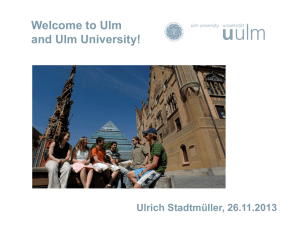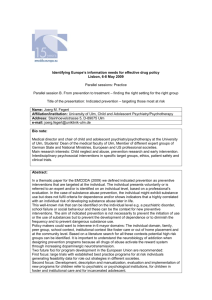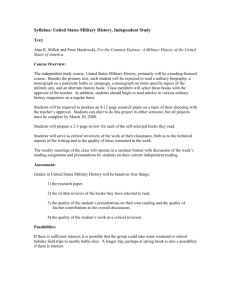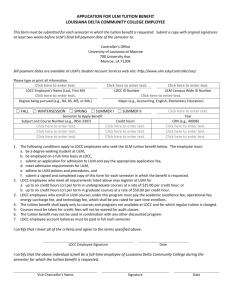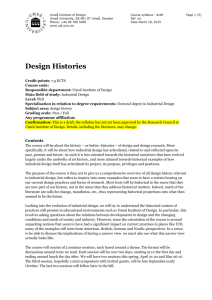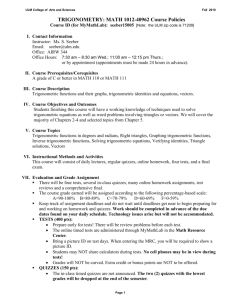ULM - November 2014 - British Pharmacopoeia
advertisement
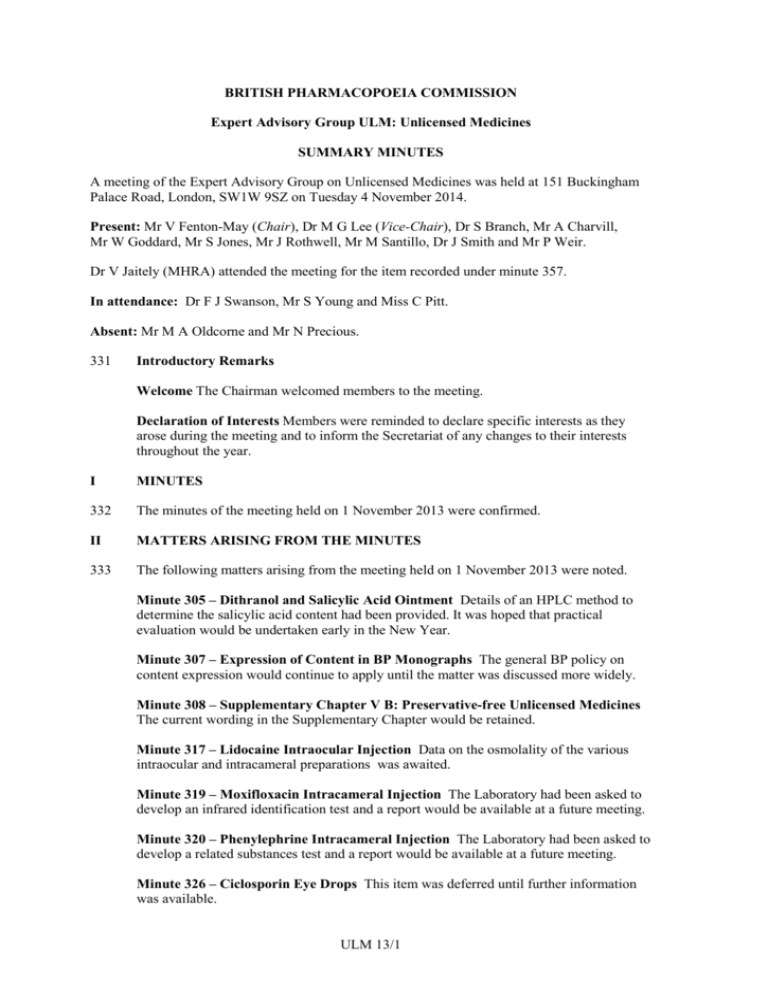
BRITISH PHARMACOPOEIA COMMISSION Expert Advisory Group ULM: Unlicensed Medicines SUMMARY MINUTES A meeting of the Expert Advisory Group on Unlicensed Medicines was held at 151 Buckingham Palace Road, London, SW1W 9SZ on Tuesday 4 November 2014. Present: Mr V Fenton-May (Chair), Dr M G Lee (Vice-Chair), Dr S Branch, Mr A Charvill, Mr W Goddard, Mr S Jones, Mr J Rothwell, Mr M Santillo, Dr J Smith and Mr P Weir. Dr V Jaitely (MHRA) attended the meeting for the item recorded under minute 357. In attendance: Dr F J Swanson, Mr S Young and Miss C Pitt. Absent: Mr M A Oldcorne and Mr N Precious. 331 Introductory Remarks Welcome The Chairman welcomed members to the meeting. Declaration of Interests Members were reminded to declare specific interests as they arose during the meeting and to inform the Secretariat of any changes to their interests throughout the year. I MINUTES 332 The minutes of the meeting held on 1 November 2013 were confirmed. II MATTERS ARISING FROM THE MINUTES 333 The following matters arising from the meeting held on 1 November 2013 were noted. Minute 305 – Dithranol and Salicylic Acid Ointment Details of an HPLC method to determine the salicylic acid content had been provided. It was hoped that practical evaluation would be undertaken early in the New Year. Minute 307 – Expression of Content in BP Monographs The general BP policy on content expression would continue to apply until the matter was discussed more widely. Minute 308 – Supplementary Chapter V B: Preservative-free Unlicensed Medicines The current wording in the Supplementary Chapter would be retained. Minute 317 – Lidocaine Intraocular Injection Data on the osmolality of the various intraocular and intracameral preparations was awaited. Minute 319 – Moxifloxacin Intracameral Injection The Laboratory had been asked to develop an infrared identification test and a report would be available at a future meeting. Minute 320 – Phenylephrine Intracameral Injection The Laboratory had been asked to develop a related substances test and a report would be available at a future meeting. Minute 326 – Ciclosporin Eye Drops This item was deferred until further information was available. ULM 13/1 Minute 327 –Glycopyrronium Bromide Oral Solution Further information was awaited on a possible related substances test. Minute 328 – Hydrocortisone Acetate Oral Suspension The finalised report on Related substances and Assay was awaited. Minute 329 – Isoniazid Oral Solution Revision of the Oral Solution monograph had been deferred until the method in the parent monograph had been finalised and in view of the discussions taking place through the EAG on Medicinal Chemicals 1 (MC1). III REPORTS AND CORRESPONDENCE 334 Government Security Classifications Members noted that the Government security classification policy had been replaced by a new three-tier system: OFFICIAL, SECRET and TOP SECRET. Going forward all relevant pharmacopoeia documents would include the OFFICIAL – SENSITIVE classification but no retrospective changes were required. 335 Membership ULM(14)2 A current membership list had been provided for information and members were asked to provide corrections, if necessary, to the Secretariat. Members noted that the membership of all the BP Commission’s Expert Advisory Groups, Panels of Experts and Working Parties would expire on 31st December 2014. The Commission had recently undertaken a review of membership of all the groups and appropriate letters would be sent in due course. 336 British Pharmacopoeia 2015 ULM(14)3 The special anniversary edition of the British Pharmacopoeia 2015 had been published in August 2014 and would come into effect on 1st January 2015. An innovation for this new edition was the introduction of the BP in a USB format (replacing the CD-ROM). The BP 2015 contained all of the text from the 8th edition of the European Pharmacopoeia, together with that from Supplements 8.1 to 8.2. Updates to the online version of the BP 2015 would be made during the year, as for previous editions, adding the text of Supplements 8.3, 8.4 and 8.5. A list of the 8 new monographs and 4 revised texts published in the BP 2015 that were the responsibility of this EAG had been provided for information. Complimentary copies of the BP 2015 had been circulated and members were asked to inform the Secretariat if they had not received their copy. Lidocaine Intraocular Injection; Moxifloxacin Intracameral Injection; Phenylephrine Intracameral Injection The British Pharmacopoeia Commission had endorsed the recommendations of this EAG regarding the inclusion of the terms “intraocular” and “intracameral” in the monograph titles in light of the specialised used of the formulations and the existing precedent set by the monograph for Cefuroxime Intracameral Injection. Sterile Sodium Acetate Concentrate Stability data to support the proposed content and pH limits had been provided after the last meeting. It was noted that the concentrate was provided in a glass vial and the requirements in Appendix XIX B: Glass containers for Pharmaceutical Use would apply. ULM 13/2 337 Lisinopril Oral Solution ULM(14)4 Related substances The Secretariat had received a report that the current HPLC method did not separate impurities C (S,S,S-diketopiperazine) and D (R,S,S-diketopiperazine). Further information on the results obtained using the BP method, and batch data in relation to the limits, was awaited. Limits During development of the monograph, a limit for diketopiperazine had not been included as there had been no indication of the presence of diketopiperazine in the Oral Solution from the chromatograms provided in the original data. A member noted that whilst the method in the monograph for Lisinopril Tablets did not separate impurities C and D, the method in the parent monograph did. It was agreed that the limit for diketopiperazine from the tablets monograph should be included until such time that further information became available. System suitability The Laboratory would develop a system suitability test based on the separation between Lisinopril and Lisinopril Diketopiperazine when the current lisinopril dihydrate BPCRS was due to be replaced or retested. It was agreed that the Laboratory should also be asked to confirm the limits for diketopiperazine in the Oral Solution during the retest and a member agreed to provide samples to the Laboratory. 338 Spironolactone Oral Suspension ULM(14)5 Dissolution Further work had been undertaken by the BP Laboratory using a range of dissolution media and a copy of the full report had been provided. The recovery of spironolactone had been less than 5% after 45 minutes and less than 10% after 90 minutes. In view of the long-established use of the formulation, it was agreed that no dissolution test should be added to the monograph at this time. A member agreed to provide further information when available. Particle size Despite the problems with the Dissolution test members agreed that particle size should not be included in the monograph as it was not clear whether the same limit would be suitable for all the available formulations. 339 Dispensing and Supply Statements ULM(14)6 A review of statements in BP monographs relating to dispensing and supply was being undertaken in consultation with the EAGs responsible for the monographs and other stakeholders. Amendments would be made in a future publication as appropriate. 340 Extemporaneous Preparations ULM(14)7 A review of monographs containing Extemporaneous Preparation information was being undertaken in consultation with the EAGs responsible for the monographs and other stakeholders. Amendments would be made in a future publication as appropriate. 341 Supplementary Chapter V E: Extemporaneous Preparations ULM(14)8 Members were informed that consideration would be given to the inclusion of additional extemporaneous formulation details once the proposals outlined in the preceding paper [ULM(14)7] had been considered by the EAGs responsible for the affected monographs. ULM 13/3 Feedback received from members of EAG ULM had indicated that the inclusion of nonmandatory formulae provided useful guidance to users of the BP. IV NEW MONOGRAPHS AND OTHER TEXTS 342 Work Programme ULM(14)9 Current Work Programme The work programme had been updated to reflect changes since the last meeting and the monographs that had been published in the BP 2015. Amisulpride Oral Solution/Suspension; Amitriptyline Oral Solution/Suspension; Amlodipine Liquid; Gabapentin Oral Solution/Suspension; Ramipril Oral Solution/Suspension These items would be removed from the list either due to the existence of licensed products or for other reasons. Co-Dydramol Oral Suspension; Sertraline Oral Suspension; Zopiclone Oral Solution/Suspension A member agreed to provide information on these items. Tretinoin Ointment A member agreed to provide information on this item. British Pharmacopoeia Commission A paper had been presented to the BP Commission providing a progress report on the work relating to Unlicensed Medicines. Members had remained committed to developing monographs for unlicensed medicines but had expressed concern about the difficulties in obtaining adequate information. It had been suggested that some project work could be carried out by university students and members agreed that this approach might offer a way forward if information was not forthcoming. Top 500 Special Order Products A review of the top 500 Special Order Products for 2013 (available from the Prescription Services website) had been carried out. A preliminary review of the list had indicated that many of the items were either the subject of a BP monograph or were already on the work programme for EAG ULM. This still left a large number of items that could potentially be added to the work programme, although it was recognised that the usage of many items was quite low. The Secretariat agreed to examine the list against available information with a view to identifying additional monographs to add to the work programme. Review of Data Members agreed that the top 500 Special Order Products was a useful source of information to help identify potential new monographs. Chloral Hydrate Oral Solution The Secretariat agreed to look into the origin of the Definition statement and to amend the monograph if required. 343 Work Programme: Monographs for Omission ULM(14)9a Expert Advisory Group MC3 (Medicinal Chemicals) had identified a number of published monographs within their remit for which licensed products were no longer available. The group had suggested that EAG ULM should be asked whether any of the items were used as unlicensed medicines before a recommendation to omit the monographs from a future publication was submitted to the BP Commission. The majority of the items did not appear to be used and members agreed that, subject to the points below, these items should be omitted from a future edition of the BP. ULM 13/4 Benzatropine Tablets; Dydrogesterone Tablets; Halibut-Liver Oil Capsules; Ergometrine Tablets The products did not appear to be widely used and it was agreed that the items should be omitted from a future edition of the BP rather than transferred to EAG ULM. Oxymetholone Tablets This item was available from Special Order Manufacturers for use in aplastic anaemia. It was agreed that the monograph should be transferred to EAG ULM and that the parent monograph should remain under the responsibility of EAG MC3. 344 Betamethasone Valerate and Coal Tar Ointment ULM(14)10 The draft monograph would be included in a future publication, subject to resolution of any outstanding points. 345 Tobramycin Oral Solution ULM(14)11 The draft monograph would be included in a future publication, subject to resolution of any outstanding points. 346 Parenteral Nutrition Solutions ULM(14)12 The draft Supplementary Chapter would be included in a future publication, subject to resolution of any outstanding points. V MONOGRAPHS IN PROGRESS 347 Bendroflumethiazide Oral Suspension ULM(14)13 The draft monograph would be included in a future publication, subject to resolution of any outstanding points. 348 Ceftazidime Eye Drops ULM(14)14 The draft monograph would be included in a future publication, subject to resolution of any outstanding points. 349 Clotrimazole Eye Drops ULM(14)15 The draft monograph would be included in a future publication, subject to resolution of any outstanding points. 350 Lorazepam Oral Solution; Lorazepam Oral Suspension ULM(14)16 The draft monographs would be included in a future publication, subject to resolution of any outstanding points. 351 Miconazole Eye Drops ULM(14)17 The draft monograph would be included in a future publication, subject to resolution of any outstanding points. ULM 13/5 VI REVISION OF MONOGRAPHS 352 Monographs for Anti-epileptic Drugs ULM(14)18 Following a review, the Commission on Human Medicines had classified anti-epileptic drugs into three categories: category 1 – drugs for which the need to maintain patients on a specific manufacturer’s product had been identified; category 2 – drugs for which the need to maintain patients on a specific manufacturer’s product should be based on clinical judgement and consultation with the patient and/or carer; category 3 – drugs for which it was usually unnecessary to ensure that patients were maintained on a specific manufacturer’s product. This matter had been discussed by the British Pharmacopoeia Commission and a number of changes had been agreed for inclusion in the British Pharmacopoeia 2016. A number of members questioned whether the proposed non-interchangeability statement was required for Oral Solutions since it was expected that solutions from different manufacturers/suppliers should be bio-equivalent. It was pointed out that oral solutions were not necessarily interchangeable, particularly those containing sorbitol or other sugars. The list of affected drugs only included the drug name, not the associated dosage form(s) and members agreed that it would be useful to clarify if the need to maintain patients on a specific manufacturer’s product related solely to oral dosage forms or to all formulations. After further discussion it was agreed that the BP should not deviate from the CHM guidance, which related to the specific drug and NOT to the type of formulation. It was recognised that for unlicensed medicines it would be almost impossible to ensure that a patient received the same product during their course of treatment, particularly if they moved to a different region. Although it was agreed that continuity of treatment was important, the consensus was that it was not appropriate to include the noninterchangeability statements in monographs for unlicensed medicines. It was agreed that a recommendation to include the patient monitoring statement rather than the noninterchangeability statement should be brought to the attention of the BP Commission. 353 Melatonin ULM(14)19 Related substances The Secretariat had received a report of long retention times and problems meeting the system suitability requirements using the column specified in the published method. The user had indicated that using a different column enabled the system suitability requirement to be met, but that the retention times were still long; data to support the request for revision was awaited. It was agreed that no change should be made to the monograph since changes to the column or the mobile phase were permitted in accordance with the parameters listed in the Appendix on Chromatographic Separation Techniques. 354 Melatonin Capsules ULM(14)20 Related substances The Secretariat had received a request to increase the limit for unspecified impurities from 0.1% to 0.2% to reflect the ICH Q3B (R2) identification thresholds. It was noted that the preferred BP Commission policy was to include ICH limits unless it could be otherwise justified. It was noted that the user had not interpreted the threshold correctly according to the ICH guideline and it was agreed that the limits should not be revised at this time. ULM 13/6 355 Methotrexate Oral Solution ULM(14)21 Identification The monograph for Methotrexate Oral Solution had been published in the BP 2015 including three Identification tests: UV, TLC and cross-reference to the HPLC Assay. A statement had been included in the TLC test to alert users to the fact that the method was not suitable for viscous formulations. A member reported problems carrying out the TLC test as the formulations were too viscous to move up the plate and it was agreed that the TLC test should be removed from the monograph. 356 Omeprazole Oral Suspension ULM(14)22 The MHRA Laboratory had examined the suitability of the current Dissolution test and examined a buffer capacity test in view of reported problems. Alkalinity It was agreed that the pH requirements should be deleted as the current limits excluded some existing formulations. Dissolution It was agreed that the Dissolution test should be deleted as it was understood that the active ingredient was present in alkaline solution and as the available products did not meet the requirements. In line with the monograph for Spironolactone Oral Suspension a statement that the dissolution test did not apply would be included. Buffer Capacity It was agreed that the drafted test for buffer capacity (a measure of the efficiency of a buffer in resisting changes in pH) should be included in the monograph. It was noted that the limit should be based on the results for one dose of the formulation and this would be confirmed. Inclusion of the test should not restrict formulations from containing buffers other than sodium bicarbonate, providing they met the monograph requirements. 357 Paediatric Oseltamivir Oral Solution ULM(14)23 Related substances A stability study had recently been carried out on the solution which had been refrigerated for 120 days and showed that the product had met the limits for Related substances at the end of this period. A report would be provided when available. It was agreed that the limits should remain unchanged at this time, and that consideration could be given to revising the limits if further information became available at a later date. VII GENERAL MATTERS 358 Chloroform-containing Preparations ULM(14)24 The Secretariat thanked members for their comments on the paper on Chloroformcontaining Preparations which had been previously circulated by correspondence. Comments from a number of Expert Advisory Groups on this matter had been drawn to the attention of the BP Commission. It had been agreed that Chloroform should be removed as an ingredient from the BP through the revision or omission of all the affected monographs at the earliest opportunity. Supplementary Chapter V: Unlicensed Medicines It was agreed that the Supplementary Chapter on Unlicensed Medicines should be revised to recommend that the use of chloroform should be avoided. ULM 13/7 Specific Monographs In response to a request from the Panel of Experts on Inorganic and General Chemicals (Panel IGC), members discussed the extent of usage of the following preparations which contained extemporaneous preparation details. Paediatric Ferrous Sulfate Oral Solution; Magnesium Sulfate Mixture It was understood that these formulations were still used and it was agreed that following removal of the extemporaneous preparation in the BP 2016 the monographs should be transferred to EAG ULM. Compound Sodium Chloride Mouthwash The preparation was not widely-used and consideration would be given to omitting the monograph from a future publication. 359 Bacterial Endotoxins ULM(14)25 The Secretariat updated the group regarding the discussions of the EAG on Biological and Biotechnological Products (BIO) and the British Pharmacopoeia Commission in relation to whether or not a test for Bacterial endotoxins should be included in individual monographs. Members were informed that the current recommendation of the BP Commission was that for new BP formulation monographs reliance should be placed on the general requirements and tests should not be included in individual monographs. The Aide Memoire would be revised once the recommendations had been finalised. 360 International Activities ULM(14)26 Members noted a number of activities relating to unlicensed medicines. 361 Pan-European Paediatric Formulary ULM(14)27 Attention was drawn to the project for the elaboration of a pan-European formulary for unlicensed paediatric medicines. The aim of the project was to compile a harmonised European formulary of suitable formulations for paediatric use and the preparations described in the future formulary would be required to meet the requirements of the Ph. Eur. general monograph for Pharmaceutical Preparations. Members would be kept informed of any developments that might affect the work of this Expert Advisory Group. 362 Aide Memoire ULM(14)28 Members noted the revised Aide Memoire which had been re-structured and updated to incorporate recent Commission decisions. VIII ANY OTHER BUSINESS 363 Membership Mr Fenton-May noted that this would be his last meeting as Chair of the Group as Dr Lee would become Chair following the membership review. The Secretariat thanked Mr Fenton-May for his contribution as Chair of the group since it was first established. 364 Date of next meeting To be arranged. ULM 13/8

